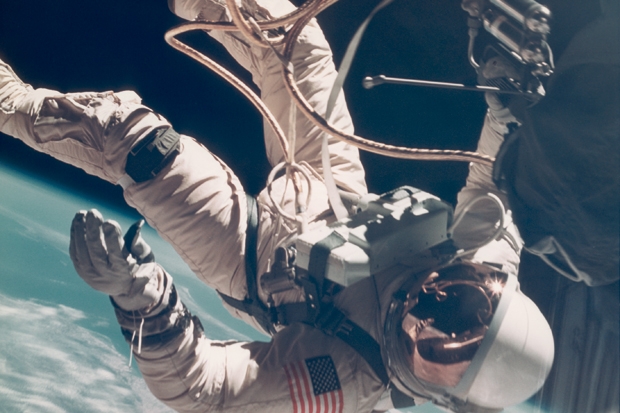When people ask why I’m obsessed with the Apollo moon missions, I always want to reply using the same phrase: ‘Because they were out of this world.’ I never do, because it happens to sound like a very bad joke. But it’s the truth. For the first time ever, mankind left its home turf and discovered somewhere new. It was qualitatively the greatest journey in human history. Not — and this is the point — that it was mankind rejecting that home turf; leaving the Earth made us value it all the more. That’s where the greatness lay. It’s also the charm of a new exhibition in London.
Encountering the Astronomical Sublime: Vintage Nasa Photographs 1961–1980 at Breese Little in Clerkenwell covers, as the dates will tell you, more than just the Apollo landings (which lasted from only 1969 to 1972). There are shots of an early spacewalk undertaken by Ed White, of the surface of Mars captured by the unmanned Mariner probe, even of far-flung Jupiter taken by Voyager 2. But the most powerful images are those of Earth. You can go on the most incredible journey in the world, but the moment that really blows your mind is when you turn round and look towards home. The Apollo 8 astronauts were the first people ever to leave Earth’s orbit and travel to the moon — yet what moved them more than anything was gazing back over those quarter of a million miles and seeing their home planet hanging in space. It was said to look like a blue marble. This is now the nickname given to their photos, the famous ‘Earthrise’ shots which are always the priciest of the Nasa images that come up for sale.

But not even these shots, as Josephine Breese of the gallery explains, are going to break many pockets. ‘Prices are still really low, because no one knows how many images Nasa have got left to release. These are the actual shots, printed by Nasa soon after the film returned to Earth, and yet even a “full marble” is still only £2,000. A lot of the images we’re selling here are just a few hundred.’ In the early days Nasa supplied them to newspapers simply as publicity material, but then realised they could provide an income stream. Periodically, they release more to auction houses. Plus, there are all the ex-employees of the agency who have photos stored in their attics, which they’re fully entitled to sell because copyright lapsed years ago. With all this material still to come on to the market, prices are still pretty earthbound.
The 1965 spacewalk shot is a perfect example of the emotional punch the images can deliver. Ed White is connected by a 25-foot cord to his Gemini spacecraft, but instead of empty black space as his backdrop — which would be pointless, you might as well have photographed him in front of a curtain — the frame is half-filled with the Earth. White clouds encircle the planet like padding around a fragile object in a wooden crate. Peaking out from beneath them is a land mass, with a huge bay facing on to an ocean. It’s recognisably the home we all inhabit, but seen from an angle that for a few seconds makes you forget to breathe. Ed White was so reluctant to end the walk that ground control had to order him back into the craft.

The man behind the camera was James McDivitt. ‘The Gemini was quite small,’ he explained later. ‘My head was up against the canopy …So I’d take the camera down and look to see where Ed was, and then put the camera up, point in that direction and take the picture. I’m a good pistol and rifle shot. Maybe that helped.’ The story highlights how much mishap and humour there was in Nasa’s programme. The most interesting astronauts were the ones — like Apollo 14’s Alan Shepard, he of the lunar golf shot — able to stand outside the mere engineering of what they were doing and take a moment to savour what it meant to them. Shepard, as far as we know, was the only man to cry on the moon, so moving did he find the experience of looking back at Earth.
Another moonwalker in the same vein was Alan Bean, whom I interviewed for The Spectator a couple of years ago. He told me that he got Nasa to pack freeze-dried pasta as his meal, just so he could be the first man to eat spaghetti on the moon. There are only still pictures of him and his colleague Pete Conrad up there — as Bean unpacked their video camera he accidentally pointed it at the sun, so burning out the lens. At least it saved him McDivitt’s worries about framing.

Josephine tells me she wasn’t much of a spacehead before the show opened. ‘I left that sort of thing to Henry [Little, her partner]. He’s a real fan. But seeing the enthusiasm of people for the images has really got me interested in the subject.’ She’s noticed a definite bias. ‘I don’t want to sound like I’m stereotyping or anything, but it’s definitely males aged between 25 and 45.’ At this point, I shuffle awkwardly. An exception to the rule, at least on age grounds, was the seven-year-old boy who visited while the gallery was showing For All Mankind, the 1989 documentary about Apollowith music by Brian Eno. ‘He knew the whole thing word for word, he was narrating along with it.’
This, I would argue (and not just to draw attention away from my shuffling), sums up the fascination of the Nasa missions: they give us the chance to be a child again, to indulge the sense of wonder that came so naturally when we were small. As the marketing tagline for another Apollo documentary, 2007’s In the Shadow of the Moon, put it: ‘Remember when the whole world looked up.’ But then again, as the images in this exhibition remind us, the truly lucky ones were the astronauts who got to look down.
‘Encountering the Astronomical Sublime: Vintage Nasa Photographs 1961–1980’ runs until 25 October at Breese Little, 30b Great Sutton Street, EC1 (www.breeselittle.com).






Comments